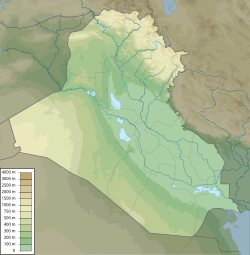Top Qs
Timeline
Chat
Perspective
Al-Abbas Shrine
Mosque in Karbala, Iraq From Wikipedia, the free encyclopedia
Remove ads
The Al-Abbas Shrine (Arabic: حَرَم أَبا الْفَضْل الْعَبَّاس, romanized: Ḥaram ʿAba al-Faḍl al-ʿAbbās) is the mausoleum of Abbas ibn Ali and a Shi'ite mosque, situated near the Imam Husayn shrine, located in Karbala, in the Karbala Governorate of Iraq. Abbas was son of Ali ibn Abi Talib and the half-brother of both Imam Hasan and Imam Husayn. Abbas ibn Ali was Husayn's flag-bearer in the Battle of Karbala and chief of his caravans. One of the holiest sites in Shia Islam, the shrine is revered by Shia Muslims who visit it every year, especially in the month of Muharram.
Environmental effects over the years have caused the Euphrates river to change course.[1] Nearly 1,400 years after the Battle of Karbala, the river flows across the grave of Abbas and encircles it.[1] It is said that the Euphrates has come to ‘Abbās now.
Since 2012, the shrine has undergone a series of enhancements and additions, such as the re-gilding of the dome, and more recently covering the former courtyard with a roof to provide improved accommodation for the millions of pilgrims who visit the shrine annually, and who come from all over the world.[2]
Remove ads
History and design

Emperors and kings of various dynasties have offered valuable gifts and gems to the shrine of Al-Abbas ibn Ali. In 1622, Abbas Shah Safavi ordered the decoration of the grave's dome. He built a window around the grave and organized the precinct.[3]
During the Ottoman era, the shrine was reconstructed by the Ottoman Sultans Suleiman the Magnificent, Murad III, and Murad IV.[4]
The majority of the modern design was done by Persian and Central Asian architects. The central teardrop shaped dome is an ornately decorated structure, with an internal and external dome. The internal dome visible from the inside is ornately decorate with fine mirror work. Two tall minarets stand on the domes sides, and were gilded in gold in the 2007 renovation works. The tomb is covered with pure gold and surrounded by a trellis of silver, along with Iranian carpets rolled out on the floors.[5]
Remove ads
Renovation
Summarize
Perspective

Beginning in 2012, the Al Abbas mosque underwent extensive renovations intended to improve the ability of the shrine to accommodate the millions of pilgrims who visit each year. The renovations included rebuilding the wall surrounding the shrine and turning it into a multi-story building housing museums, offices, and additional prayer halls.[6] The dome and minaret have also been re-gilded, and the shrine's courtyard has been covered with a roof.[2]
In 2014, construction began on a basement intended to further accommodate pilgrims. The basement is located under the perimeter of the main courtyard and involves systematically closing off parts of the courtyard and then excavating the current court yard. The project dealt with foundational issues of the shrine and reinforced the structure whose foundation has water gaps in it; as part of the Euphrates runs around the grave of Abbas.[7] When complete, pilgrims will have access to the sardab of Abbas and it will be the closest point to the actual grave. In March 2016, a new Zarih for the grave of Abbas was completed. It is the first Zarih to be fully built in Iraq by Iraqi hands, and was duly inaugurated on the 13th of Rajab the birth of Imam Ali, on April 21, 2016.
Remove ads
Timeline
Remove ads
Customary greeting
«السلام علیک یا ابوالفضل العباس»
"As Salamo Alaika Ya Abolfazl El-Abbas"
"Peace be upon you, O Abu al-Fadl al-Abbas"
It is customary among Muslims, especially Iranian Shi'ite Muslims, to whisper, either in person when approaching the shrine or when viewing a picture of the shrine on media: «السَّلامُ عَلَیْکْ یا اَبَا الْفَضْلِ الْعَبّاسَ», "Alsũlãạmu ʿAlaẙ̰ḵ̊ y̰ā Aabā Al̊faḍ̊li Al̊ʿabãạs"; This is an Arabic phrase which meaning: "Peace be upon you, O Abu al-Fadl al-Abbas." This action called "giving greetings to the Imams."[19][20][21][22][23]
Remove ads
Titles
Summarize
Perspective
Abbas ibn Ali was a young man with a good reputation among the people.[24] He was given many good nicknames, including:[25]
- → «ابوالفضل»: "Abo al-Fazl", his Kunya, literally means "The Father of Goodness";
- → «عباس»: "Ab'baas", literally means "The Lion of the Forest, a Lion from Whom Lions Flee";
- → «قمر بنی هاشم»: "Qamar-e Bani Hashem", literally means "The Moon of the Tribe Banu Hashem", because his charming appearance attracted attention, and his face was radiant like the full moon. This title was given to Abbas ibn Ali because of his beauty and handsome face;
- → «سقّا»: "Saq'qaa", literally means "Someone Who Gives Water to the Thirsty." At the age of 33, on the day of Ashura, 10 Muharram 61 AH, while fetching water for his thirsty brother Hussein, Abbas ibn Ali lost his hands in the war, causing the waterskin to fall from his hands, and was then killed. The principle of providing water to the thirsty in Islamic religious teachings, especially Shia Islam, is very popular and reminds everyone of Abbas ibn Ali.
- → «بابُالحَوائِج»: "Baab ol-Hawaa'Ej", literally means "Entrance of Desires". It is well known among Muslims that whatever you ask of Abbas ibn Ali in your heart, he will surely grant it. That is because of the reputation he has with God.
- → «بابُ الحُسین»: "Baab ol-Hossein", literally means "The Way to See Hussein". Since childhood, Abbas ibn Ali had served his older brother Hussein intensely and cared for him very much, to the point that he lost his life in the process.
Overall, Abbas ibn Ali is known among Muslims, especially Shi'ites, for his chivalry, loyalty, and devotion to God.[26][27]
Remove ads
Gallery
See also
References
External links
Wikiwand - on
Seamless Wikipedia browsing. On steroids.
Remove ads














